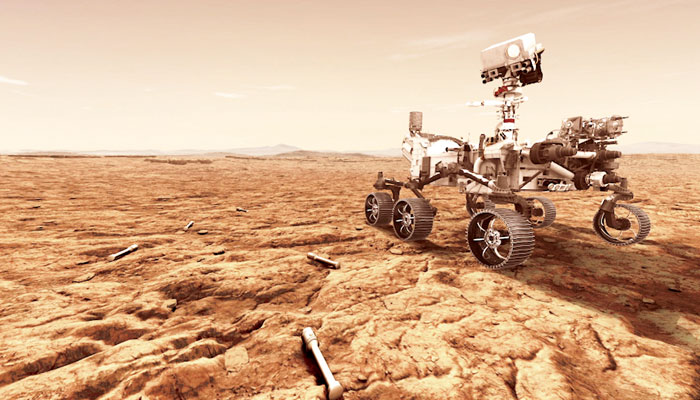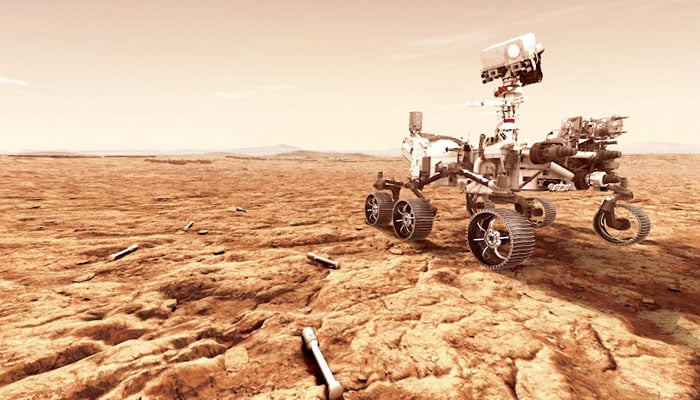
The US space agency continues to launch new spacecraft and Heli launches into space to reveal new discoveries and hidden secrets in Nasakhla. In this regard, NASA’s rover was sent to Mars last year. This mission was called the first link in the chain of bringing rock samples from the Red Planet to Earth.
A few months ago, the third space mission was launched to Mars. Earlier, a space mission of the United Arab Emirates reached the orbit of Mars, while after that the Chinese space vehicle also reached the orbit of the red planet. It is the largest American rover to land on Mars, accompanied by a helicopter.
NASA named the process of landing the vehicle on the surface of Mars as the “show”. The speed of the mission was gradually reduced from 20,000 kilometers per hour while moving towards the surface of Mars. In addition to the parachute, a jet engine was also used to reduce the speed, after which the speed of this rover was reduced to three kilometers per hour while landing on the surface of Mars. This six-wheeled vehicle on Mars is north of the Martian equator. Landed near Jezero Crater.
Importantly, the Curie Usti rover is still operational, but it is three thousand seven hundred kilometers away from Gale Greater. The American mission was the first to start the search for water and life on the planet after landing the rover named Perseverance on the surface of Mars. In addition, the mission included obtaining and storing samples of Martian rocks and stones. Over the next ten years, joint US and European missions will retrieve these samples and deliver them to Earth. The American Rover owns a helicopter named Ingenuity. This helicopter is actually an experimental instrument, through which NASA aims to obtain information about flying and landing on the Martian surface.
Now the Perseverance rover is close to completing its initial mission on Mars. The NASA spacecraft has collected samples of different types of rocks, which will soon be collected at a location on the surface and the mission’s mission. Can be brought to earth with help. According to experts, 17 months ago, the spacecraft left the rocket and arrived at Jezero (the location of the crater). From what Perseverance has seen so far, scientists are satisfied that it is in the best place to search for life. available.
The harsh environment on Mars makes life unlikely, but the rover is looking for a sample that could show that Jupiter was filled with a pond billions of years ago. “If this state of Jezero had existed anywhere on Earth at any point in the last 3.5 billion years, it would be safe to assume that biology would have changed,” says Dave Duchster, a scientist on the Severance mission at the University of California, Berkeley. These stones may have left signs that we can observe.
NASA and the European Agency are working together on this project, so that samples of these rocks can be brought to Earth soon. Experts say it will be an astonishing project, which will include a new landing system, Heli’s putter, a rocket to Mars and a spacecraft that will go from one planet to another. Experts are trying to bring these samples to earth by 2033.
Perseverance excavated the surface of the crater and collected some rock samples that were part of the volcano. These samples will reveal what was there before the Jezera ponds were filled with water. They are thought to have been obtained from rock types whose evaluation will reveal how old they are. Experts say that in the current conditions, a date on Mars can only be estimated indirectly. The samples were collected from delta deposits in the western part of the 45-kilometer-long crater. Deltas are structures formed by fluvial sands when water flows forward.
Geologically, these may be samples that contain information about past microbial life. Sediment (composite particles) type samples were collected from a rock known as “Wildcat Ridge”. After the evaporation of the water on the Jezero canal, this place was formed from the mixture of clay, sand and mud. Preliminary observations by the rover have shown that the Wildcat Ridge contains organic (biological), i.e. carbon, compounds. This is an interesting but limited observation. Sananda Sharma, mission instrument scientist at NASA’s Jet Propulsion Laboratory (JPL), says that all living things are made of organic compounds, but the important thing is that organic compounds can also be made by chemical processes and not necessarily. Be related to a living being.
For example, they can be formed by mixing water and stone. Organic material is also present in interstellar dust. Over the past four months, Perseverance has worked on the 40-meter-high slope that sits on the edge of the delta. Soon, the robot will reach the smooth surface of the crater, where samples of these rocks will be collected in protected titanium tubes, then brought together on the surface.
JPL’s project systems engineer Rick Welch says we’ll try to put 10 to 11 such tubes on the surface. It may take up to two months for the samples to be placed there, and then a careful record will be made of where they are placed, so that they can be found on future missions. NASA engineers are working on how to deploy the tubes. These tubes are currently in Perseverance’s stomach. The JPL lab has a copy of this rover. After experimenting on it, they are replicated on Mars.
The transfer of these samples to the depot is being planned as a precaution, as it is possible that they may be damaged during the remainder of the rover mission. The samples will therefore be transported to a location, so that they can be brought to Earth. Scientists also want to collect more samples. So the transition to Earth will focus on where the robot goes in the future. The final decision will be made by events on Mars. Experts say that we have not only gone to the right place, but we have sent the right spacecraft with the right equipment, so that a final decision can be made by seeing and understanding the ancient and interesting atmosphere of Mars.
setTimeout(function(){
!function(f,b,e,v,n,t,s)
{if(f.fbq)return;n=f.fbq=function(){n.callMethod?
n.callMethod.apply(n,arguments):n.queue.push(arguments)};
if(!f._fbq)f._fbq=n;n.push=n;n.loaded=!0;n.version=’2.0′;
n.queue=[];t=b.createElement(e);t.async=!0;
t.src=v;s=b.getElementsByTagName(e)[0];
s.parentNode.insertBefore(t,s)}(window,document,’script’,
‘https://connect.facebook.net/en_US/fbevents.js’);
fbq(‘init’, ‘836181349842357’);
fbq(‘track’, ‘PageView’);
}, 6000);
/*setTimeout(function(){
(function (d, s, id) {
var js, fjs = d.getElementsByTagName(s)[0];
if (d.getElementById(id)) return;
js = d.createElement(s);
js.id = id;
js.src = “//connect.facebook.net/en_US/sdk.js#xfbml=1&version=v2.11&appId=580305968816694”;
fjs.parentNode.insertBefore(js, fjs);
}(document, ‘script’, ‘facebook-jssdk’));
}, 4000);*/



